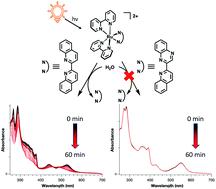当前位置:
X-MOL 学术
›
Dalton Trans.
›
论文详情
Our official English website, www.x-mol.net, welcomes your
feedback! (Note: you will need to create a separate account there.)
Balancing the interplay between ligand ejection and therapeutic window light absorption in ruthenium polypyridyl complexes
Dalton Transactions ( IF 3.5 ) Pub Date : 2022-06-15 , DOI: 10.1039/d2dt01237e Annie B McCullough 1 , Jiaqi Chen 2 , Nathaniel P Valentine 1 , Toney M Franklin 1 , Andrew P Cantrell 1 , Vayda M Darnell 1 , Qasim Qureshi 3 , Kenneth Hanson 2 , Steven M Shell 3 , Dennis L Ashford 1
Dalton Transactions ( IF 3.5 ) Pub Date : 2022-06-15 , DOI: 10.1039/d2dt01237e Annie B McCullough 1 , Jiaqi Chen 2 , Nathaniel P Valentine 1 , Toney M Franklin 1 , Andrew P Cantrell 1 , Vayda M Darnell 1 , Qasim Qureshi 3 , Kenneth Hanson 2 , Steven M Shell 3 , Dennis L Ashford 1
Affiliation

|
Ruthenium polypyridyl complexes have gained significant interest as photochemotherapies (PCTs) where their excited-state properties play a critical role in the photo-cytotoxicity mechanism and efficacy. Herein we report a systematic electrochemical, spectrochemical, and photophysical analysis of a series of ruthenium(II) polypyridyl complexes of the type [Ru(bpy)2(N–N)]2+ (where bpy = 2,2′-bipyridine; N–N is a bidentate polypyridyl ligand) designed to mimic PCTs. In this series, the N–N ligand was modified through increased conjugation and/or incorporation of electronegative heteroatoms to shift the metal-to-ligand charge-transfer (MLCT) absorptions near the therapeutic window for PCTs (600–1100 nm) while incorporating steric bulk to trigger photoinduced ligand dissociation. The lowest energy MLCT absorptions were red-shifted from λmax = 454 nm to 564 nm, with emission energies decreasing from λmax = 620 nm to 850 nm. Photoinduced ligand ejection and temperature-dependent emission studies revealed an important interplay between red-shifting MLCT absorptions and accessing the dissociative 3dd* states, with energy barriers between the 3MLCT* and 3dd* states ranging from 850 cm−1 to 2580 cm−1 for the complexes measured. This work demonstrates the importance of understanding both the MLCT manifold and 3dd* state energy levels in the future design of ligands and complexes for PCT.
中文翻译:

平衡钌聚吡啶配合物中配体喷射和治疗窗光吸收之间的相互作用
多吡啶钌配合物作为光化学疗法 (PCT) 引起了极大的兴趣,其中它们的激发态特性在光细胞毒性机制和功效中起关键作用。在这里,我们报告了一系列[Ru(bpy) 2 (N-N)] 2+类型的钌 ( II ) 多吡啶基配合物的系统电化学、光谱化学和光物理分析。(其中 bpy = 2,2'-联吡啶;N-N 是双齿多吡啶基配体)旨在模拟 PCT。在这个系列中,N-N 配体通过增加共轭和/或电负性杂原子的掺入来改变 PCT 治疗窗口(600-1100 nm)附近的金属-配体电荷转移 (MLCT) 吸收,同时掺入空间位阻触发光诱导配体解离。最低能量 MLCT 吸收从λ max = 454 nm 红移到 564 nm,发射能量从λ max = 620 nm 降低到 850 nm。光诱导配体喷射和温度依赖性发射研究揭示了红移 MLCT 吸收和获得解离3之间的重要相互作用dd* 状态,对于测量的配合物, 3 MLCT* 和 3dd*状态之间的能垒范围为 850 cm -1至 2580 cm -1。这项工作证明了了解 MLCT 流形和3 dd* 态能级在未来设计 PCT 配体和配合物中的重要性。
更新日期:2022-06-15
中文翻译:

平衡钌聚吡啶配合物中配体喷射和治疗窗光吸收之间的相互作用
多吡啶钌配合物作为光化学疗法 (PCT) 引起了极大的兴趣,其中它们的激发态特性在光细胞毒性机制和功效中起关键作用。在这里,我们报告了一系列[Ru(bpy) 2 (N-N)] 2+类型的钌 ( II ) 多吡啶基配合物的系统电化学、光谱化学和光物理分析。(其中 bpy = 2,2'-联吡啶;N-N 是双齿多吡啶基配体)旨在模拟 PCT。在这个系列中,N-N 配体通过增加共轭和/或电负性杂原子的掺入来改变 PCT 治疗窗口(600-1100 nm)附近的金属-配体电荷转移 (MLCT) 吸收,同时掺入空间位阻触发光诱导配体解离。最低能量 MLCT 吸收从λ max = 454 nm 红移到 564 nm,发射能量从λ max = 620 nm 降低到 850 nm。光诱导配体喷射和温度依赖性发射研究揭示了红移 MLCT 吸收和获得解离3之间的重要相互作用dd* 状态,对于测量的配合物, 3 MLCT* 和 3dd*状态之间的能垒范围为 850 cm -1至 2580 cm -1。这项工作证明了了解 MLCT 流形和3 dd* 态能级在未来设计 PCT 配体和配合物中的重要性。











































 京公网安备 11010802027423号
京公网安备 11010802027423号